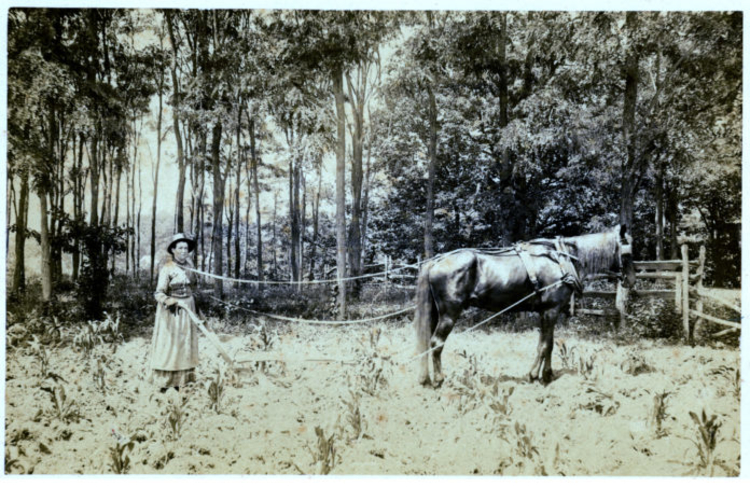Nothing could stop her — not snow, not rain, not wild animals nor robbers nor deserted dirt roads in the dead of night. She defended herself with a gun and thrashed thieves with her buggy whip.
As one of only two women in the country who carried the U.S. mail, Susanna (“Suzie”) A. Brunner was the first woman on Long Island’s North Shore in New York to be entrusted with the Port Washington-Great Neck route in the 1880s. Guiding the reins of the horse she named “William J. Tilden,” the tough daughter of immigrant German parents known as “a devil of a mail carrier” got the job done.
One has to wonder: Were she alive today, would she let politics, or prejudice, or the actions of any human decimate her postal power and sabotage her appointed rounds? Or would she just load up the buggy with precious cargo and keep on riding?
NO SHRINKING VIOLET
The gun-toting young woman chose a career that followed in the carriage tracks of women who, since before the Revolutionary War, had delivered the mail. They were popularly called “postmistresses” but the proper term is “postmasters,” according to the Smithsonian National Postal Museum, because, as one female postmaster put it, they were “not to be known as ‘any man’s mistress!’”
Brunner was born on Dodge’s Island (renamed O’Gorman’s Island then Manhasset Isle) in 1858. Her family moved when she was 1 year old to the Samuel Dodge House at One Sandy Hollow Road on the Cow Neck Peninsula, as Port Washington was then called, to a house she would live in until her death in 1933; the house still stands today.
As a young woman in her early 20s, she set out to be a letter carrier with a horse she had broken to harness herself. She knew that the mail must go through, rain or shine — a dictate that sometimes meant digging Mr. Tilden out of snowdrifts.
The job was physically draining and fraught with danger, but she faithfully worked at her routes from 1881 to 1885. Keeping regular schedules throughout Queens County — before there was a Nassau County — carriers were often targeted by thieves and other attackers, like one drunken, out-of-control photographer that crossed her path. After disappearing for a day, he was found with blackened eyes and body bruises, and died several days later. Legend has it that Brunner told a reporter that the previous day she had beaten him with the butt of her whip in his face and eyes because of his bad conduct while intoxicated. Others believed that the man died of alcohol withdrawal.
DOING A MAN’S JOB
After retiring from her route, she lived a well-rounded life and was respected in the community. When not working on her family’s farm, she and Mr. Tilden plowed others’ fields. She worked as a public school janitor and opened a store that catered to children walking to or from school, according to an account by Ross Lumpkin, a trustee at the Cow Neck Peninsula Historical Society. “Aunt Suzie,” as the locals called her, always wore an apron, even when she went to church.
After her father died, she became what one observer called “the man of the family.” Sensing the town’s rising prosperity, she purchased three properties around Sandy Hollow Road as well as the old schoolhouse, which she moved across the street.
Cow Neck was moving into the modern world: In 1898, it was renamed Port Washington, which became part of the newly established Nassau County. The same year, the Long Island Rail Road extended its Great Neck line to Manhasset and Port Washington by building a train trestle viaduct over the marshes at the southern end of Manhasset Bay. The first electric trolley line opened in 1908, carrying passengers from the Manhasset Bay Yacht Club to Roslyn.
THE MAIL MUST GO THROUGH
Despite the nation’s growth, there were still many not-so-modern beliefs, including the conviction many people had that a woman should not be doing a man’s job. In 1908 the Washington Post reported that when the civil service proposed allowing women to take the clerk-carrier exam in Alexandria, Virginia, the entire masculine population stood in the streets and denounced the proposal. One Col. Yancey shouted, “Lives there a man with a soul so dead that he would permit his mail to be carried by a female mail carrier?”
Still, although women were popularly regarded as delicate and fragile, the ones who carried mail were seen as larger-than-life legends, as prejudice began to give way to acceptance: By 1902, about 25 women worked as rural mail carriers throughout the country, and in 2019, nearly 37 percent of the country’s postal service mail carriers were women.
For more Rear View columns on Long Island history, visit longislandpress.com/category/past-present/rear-view
Sign up for Long Island Press’ email newsletters here. Sign up for home delivery of Long Island Press here. Sign up for discounts by becoming a Long Island Press community partner here.



































